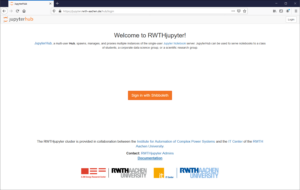
Welcome to RWTHjupyter!
Source: RWTHjupyter
At the beginning of the year, we announced that the RWTHjupyter service had entered the pilot phase. The goal is to ensure a stable process in the subsequent regular operation by building up experience, taking over operations and setting up support structures.
But have you ever wondered who are the people behind RWTHjupyter that have made it this far?
Today we introduce you to one of the developers: Steffen Vogel works as a research associate at the Institute for Automation of Complex Power Systems (ACS) and has been there from the beginning. We were allowed to interview him about the development of RWTHjupyter.
How long have you been working on RWTHjupyter?
Originally, we started building a predecessor of today’s RWTHjupyter cluster 3 years ago at the Institute for Automation of Complex Power Systems (ACS).
In the middle of 2019, we also received the funding to purchase a new cluster together with the IT Center, which we can now offer to the whole RWTH.
What is your position in the development team?
As a research assistant at the ACS, I am not directly employed at the IT Center. Therefore, I am no longer directly involved with the operation and day-to-day problems of the cluster.
I am very happy that we can now offer RWTHjupyter as a service of the IT Center. This allows me as a developer to focus on new features and innovations around the cluster again.
How did you get into the development team of RWTHjupyter?
I guess I was one of the first developers at RWTH to get involved with a larger JupyterHub cluster.
We were aware that Jupyter notebooks have been actively used in teaching for years. This was then illustrated by a great response at the first Jupyter user meeting.
Besides our faculty, Jupyter users can be found in almost all departments of the RWTH. It quickly became clear that we would need a university-wide strategy for the use of Jupyter notebooks in teaching in the long term.
Mainly out of personal interest, I started to work on the development of a scalable system that supports several hundred to a thousand concurrent users.
In the meantime, however, the team has already expanded. In addition to colleagues in the IT Center, who now mainly take care of the operation of the cluster, there is also a lot of support from the ranks of lecturers and academic staff from other institutes and disciplines.
How would you describe RWTHjupyter?
RWTHjupyter is a JupyterHub cluster that provides interactive programming environments for teaching at RWTH.
Students can use it to understand learning content deeper in the form of interactive scripts in a playful way. At the same time, RWTHjupyter can be used for practicals or exercises.
What challenges do you face in your work? What hurdles did you have to overcome during the development of RWTHjupyter?
We have tried to break new ground in some areas with RWTHjupyter. Many technologies used in the RWTHjupyter cluster were used in this form for the first time in this combination at RWTH. RWTHjupyter now uses cloud technologies like those being pushed today by giants like Google, Amazon and Netflix.
For example, RWTHjupyter is the first service based exclusively on the new Internet Protocol IPv6. In addition, RWTHjupyter runs in a Kubernetes / Cloud Cluster, which also did not exist before. These innovations make working on RWTHjupyter so exciting and challenging at the same time.
During the development of RWTHjupyter, we therefore had to work closely with the Jupyter open source community.
At the same time we were able to make important contributions to further develop the Jupyter project in general.
I also hope to deepen the experience with these new technologies at RWTH in order to possibly offer other services in a more scalable way in the future.
What has been the best moment for you so far during the development?
That was certainly the moment when we were able to log into the cluster for the first time via our RWTH login.
The integration of RWTHjupyter into the RWTH Single Sign-On was not that easy, because we also had to get the OK of the data protection officer.
Can you tell us your favorite feature of RWTHjupyter?
What I find most useful is the ability to share Jupyter notebooks with other users.
For this purpose, we created a “shared” folder for which all users have write permission. This makes it easy to share notebooks.
Are there any changes planned for RWTHjupyter in the future?
Yes! We still have some interesting features planned. Among other things, I am currently working on the integration of RWTHmoodle and sciebo. The Moode integration will hopefully allow us to rate Jupyter Notebooks in the future. Jupyter notebooks can then be more easily graded in RWTHmoodle and thus be used for grading.
This is also connected to the topic of “auto-grading”. This means the automated evaluation of notebooks, which many lecturers would like to see.
However, this is a very complex topic which we have put on the back burner for now.
The integration with sciebo will allow us in the future to show folders from the sciebo cloud as normal folders within RWTHjupyter. This will make it easier for users to copy larger amounts of data in or out of the cluster.
We thank Steffen for the interview and wish him continued fun and success with RWTHjupyter.
Responsible for the content of this article are Linda Jörres and Steffen Vogel.




